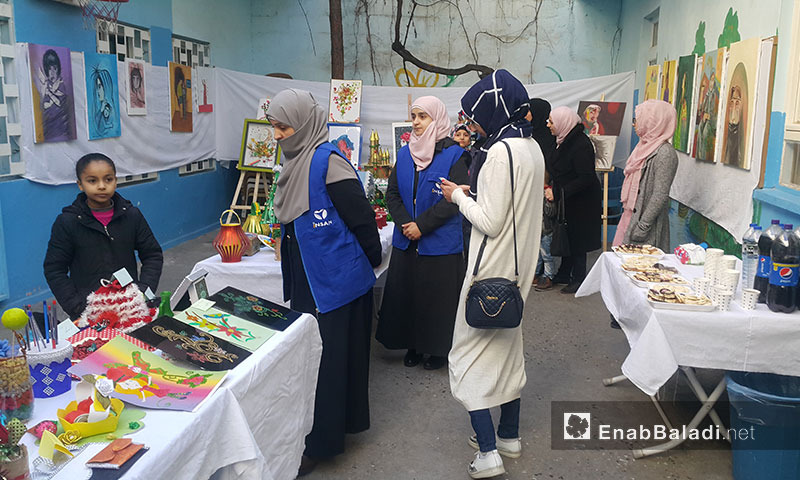“It is nice to see something that resembles us and our Arab culture,” says the Turkish young man Mohammad (21 years old), an Arab from the Turkish city of Urfa, commenting on “Insan” (Human) Exhibition, which presented the art works of Syrian adolescents, expressing joy over what he described as “the touch and cultural value added by the Syrian presence here.”
The exhibition, which “Insan” Center’s Headquarters in Urfa has incubated, ended on Saturday, 3 February. It lasted for four days and included dozens of artistic works by Syrian teens, who have been trained by the Center for days, according to its Director Yousef al-Deeb.
“Insan” Center was established late in 2011 inside Syria. Its members moved to the Turkish city of Urfa, early in 2015. The Center supports hundreds of people in the fields of art and education, including 150 children, out of whom 40 are with disabilities, in addition to 100 women, according to the Center’s administration.
Art Works Produced by Training
The Center targeted more than 50 male and female Syrian teenagers through diverse arts and sports activities. According to the Center’s Director, the trainees were divided into three groups: Painting, drama and acting, and sports. The children received training for three months under the supervision of specialized trainers and experts.
In the exhibition, 15 painting trainees participated, supervised by the painter and novelist Ayman al-Nasser, from the city of al-Raqqa, assisted by artist Ayesha al-Akla, in the sculptured and handmade works.
Al-Deeb believes that the participant teens have proved owning “massive” energy and capabilities, pointing out that, at the end of the training course, their artistic pieces have been presented to the audience through the exhibition, which contributed to the creation of a state of openness and interaction with society, as well as expression of the trainees’ skills.
Expressing Wishes
“We gave them the chance to express themselves the way they wanted, without guidance. We were amazed at what they made,” the painter Ayman al-Nasser told Enab Baladi, believing that these events, “form an opportunity to discover the talents of the teens’ who have artistic energy and potentials, that need to be discovered, cared for and sharpened.”
The exhibition included various works, such as oil and acrylic paintings, as well as sculptures and photographs. Al-Nasser assured that the exhibition was a success, for it discovered energies that can be depended on if developed, explaining that “the trainees’ have developed a lot and produced about 40 well implemented paintings, in addition to a number of beautiful handmade and art works.”
Teenage Girls and a Strong Presence
Enab Baladi interviewed a number of young girl participants. Maryam Al-Elaiwi (14 years old), form Deir ez-Zur, said that she participated with eight works, six paintings and two sculptures. The paintings spoke of Syria, Palestine and the war; she made a sculpture of Mimar Sinan who built the “Fatih” Mosque and another for the whirling dervish.
“My talents have developed, and I shifted from drawing with pencils to using colors and acrylic,” Maraym added, expressing joy for becoming more daring in her works.
Lujain al-Assi (16 years old), from Deir ez-Zur, participated with five paintings; she wished that the center would continue to support her and her friends in the field of art.
Khawla al-Issa (17 years old) participated with seven oil paintings about the Syrian woman; she said that she noticed a diversity in the subjects addressed by the paintings and other artistic works, pointing to “the mixture of hope, peace, war, fear, childhood, life and social issues.”
“We are living in a time, through which the identity of women is being generally obliterated. This exhibition is a cry of objection to society’s restrictions and a desire for liberty,” according to Khawla, who observed that “the women’s participation in society is weak and it has to be reinforced.”
There are not many organizations that show interest in the creative dimensions of teens’ lives, according to the people, whom Enab Baladi have interviewed during the exhibition, who wished continuity for these events, “that form a space of happiness, life and hope amidst life’s concerns and problems.”

